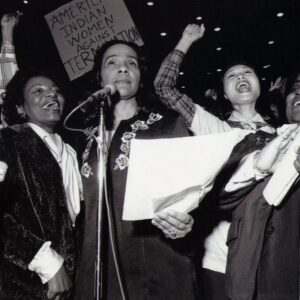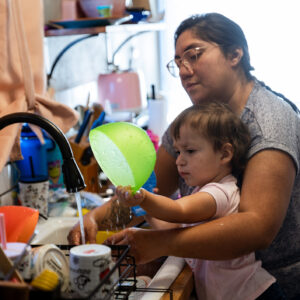Coretta Scott King, civil rights leader and author, speaking at the International Women’s Year National Women’s Conference in Houston in 1977 (Photo © Janice Rubin: www.janicerubin.com)
Letter from the CEO
The United States has made enormous progress on women’s rights, freedom, and representation over the last fifty years. But gender equality remains elusive.
Women earn six in ten Bachelor’s and Master’s degrees annually but hold less than three in ten C-Suite positions. Since anti-discrimination laws were enacted in the 1970s, women’s labor force participation has soared, reaching an all-time high in 2024. But women on average still are paid 22 percent less than men—and women who are also disadvantaged on the basis of race or ethnicity earn even less.
What is equally striking is how far behind the United States is compared to our peers. In 2024, we ranked 43rd on the Global Gender Gap Index, an annual report produced by the World Economic Forum since 2006.
We were not always this far behind. Fifteen years ago, the U.S. and Western Europe were at a roughly equivalent level on key gender equality measures. But while progress accelerated in other wealthy advanced democracies, it stalled here. Consider that Germany was ranked 5th in 2006 and 7th in 2024. Over this same period, the U.S. fell from 3rd to 22nd place on the Economic Participation subindex. The highest the U.S. has reached was 17th in 2011, during Barack Obama’s presidency. The U.S. plummeted to 51st, its lowest rank, during Donald Trump’s first term.
Yet despite this disheartening reversal of progress, in America there remains broad public support for women’s equality. Certainly, there are sharp differences by age and partisanship, with older Americans and Republicans expressing less egalitarian views. Nevertheless, large majorities still favor equality. Nine in ten agree that equal rights for women and men are very important, according to a 2020 Pew Research Center global survey. More recently, Pew found that nearly six in ten Americans think that changing gender roles “have made it easier for families to earn enough money to live comfortably.”
In short, Americans favor gender equality. The barrier to making progress is not a lack of public support. The issue is how the U.S. can advance equality. The most successful nations can provide our roadmap.
In that spirit, Gender Equity Policy Institute partnered with Professor Jennifer M. Piscopo, Director of the Gender Institute at Royal Holloway University of London, to present this report, Roadmap for an Equitable Future: Placing a Gender Lens on American Public Policy. The methods of integrating a gender equality perspective in policymaking that we survey here have become the international norm in gender policymaking over the last 25 years. But they are little known or practiced in the United States.
America has not lived up to its promise of equality, opportunity, and the pursuit of happiness for women and other people disadvantaged on the basis of gender.
It is time to try a new approach. The times demand it.
With urgency,
Dr. Nancy L. Cohen, Founder & CEO, Gender Equity Policy Institute
Executive Summary
Women’s opportunity and well-being are limited by pervasive and persistent gender inequality. The World Economic Forum projects that it will take 134 years to close the global gender gap at the current slow pace of change.
The United States is no exception. Indeed, when compared to peer countries, America’s gender gaps are particularly striking. The U.S. ranks 43rd on the Global Gender Gap Index (GGGI), far below many advanced democracies, including Germany, France, and the United Kingdom.
The U.S. can learn lessons from our counterparts and allies in wealthy democratic countries.
The highest ranked countries on the GGGI employ a two-pronged strategy to advance gender equality. Like the U.S., they target measures specifically to women—on equal pay, gender-based violence, or maternal health, for example.
Yet they don’t stop there. Crucially, they integrate gender equality considerations in public policy across the whole of government. The results are impressive. Many countries that engage in this method of gender policymaking have substantively improved women’s condition, status, and well-being. The most successful among them have also chipped away at deeply entrenched cultural and social norms around gender roles to achieve transformational change.
Different countries, regions, and international entities employ various names for their initiatives. Canada adopted a comprehensive gender perspective thirty years ago and now calls its strategy Gender-based Analysis Plus (GBA+). New Zealand integrates a gender perspective throughout policy areas under the framework “Bringing Gender In.” Entities like the European Union and the OECD use the common technical term—gender mainstreaming (GM).
Applying a gender lens broadly is now a strong international norm. Nearly every major international organization, many regional organizations, and more than 170 governments at the country or regional level have adopted initiatives to do so.
American state, federal, and local policymakers can accelerate women’s equality in the United States by adopting practices modeled on this successful global approach. Charting that path is what we seek to do here in Roadmap for an Equitable Future: Placing a Gender Lens on American Public Policy, a report produced in a partnership between the Gender Institute, Royal Holloway University of London, and Gender Equity Policy Institute, a California-based nonpartisan research organization.
Everywhere the gender perspective is mainstreamed, gender is taken into account when designing and implementing policies and programs, and a gender lens is applied to a broad range of issues affecting the public, not just those typically considered ‘women’s issues.’
More specifically:
- Advancing gender equality is a goal in the design and implementation of all relevant policies and programs
- Integrating a gender equality perspective—analyzing women’s and men’s potentially different experiences—is central to policy planning, development, and implementation across the whole-of-government and in all policy areas
- Gathering and analyzing sex- and gender-disaggregated data at all stages of the policy process is a critical tool toward advancing gender equality for women, men, and gender diverse people
- Conducting gender analysis at the planning stage ensures policies do not exacerbate inequality and surfaces ways to advance equality
- Program monitoring and evaluation (M&E) includes the gender perspective through gender equality indicators and outcomes
Our purpose in this report is to introduce American policymakers, elected officials, researchers, and advocates to this now common global approach to gender policymaking. In From the Margins to the Center, we begin by surveying the history of the activism and action that led to the widespread adoption of a whole of government gender perspective. In the next two sections, we examine how the gender equality perspective has been institutionalized in international, national, regional, and local governance. We explore some of the challenges of implementation and offer best practices for building a successful strategy.
Four sections on applying the gender perspective in specific policy domains follow. We present case studies from peer nations on gender responsive action on 1) climate change; 2) housing affordability; 3) financial inclusion; and 4) public budgets.
We end this report with an exploration of the benefits of embedding gender equality considerations in public policy broadly. We include some practical recommendations on how policymakers can do gender equality perspective integration with pilot programs and capacity-building efforts.
American women experience the consequences every day of our country’s poor standing on global gender equality measures. It is time for the United States to embrace this now common method of gender policymaking. Using the tools of gender analysis and gender responsive action, policymakers can generate rapid wins to accelerate women’s equality in the United States.
Recommended Citation
Jennifer M. Piscopo, Nancy L. Cohen, and Natalia Vega Varela, “Roadmap for an Equitable Future: Placing a Gender Lens on American Public Policy,” Gender Equity Policy Institute and Royal Holloway University of London, May 2025. https://doi.org/10.5281/zenodo.15398960
© 2025 Royal Holloway and Bedford New College & Gender Equity Policy Institute
This report was created by Jennifer M. Piscopo (Royal Holloway University of London) and Gender Equity Policy Institute over 2024-2025 under a project which was funded by the Economic and Social Research Council. The copyright in the report belongs to Royal Holloway and Bedford New College and Gender Equity Policy Institute. The report can be used under the creative commons CC BY-NC-ND license. If you wish to use the report for any other purpose please get in touch with Jennifer Piscopo via [email protected] and Gender Equity Policy Institute via [email protected] to discuss the terms of a license.
Contact
For media inquiries, email: [email protected] | [email protected]
For all other inquiries, email: [email protected]
Acknowledgments
This report was made possible by generous support from Royal Holloway University of London via a Social Science Impact Accelerator grant from the Economic and Social Research Council. Bliss Parsons designed the report. Leyly Moridi provided research and editing assistance. Additional research assistance was provided by Luka Marks. Gender Equity Policy Institute is grateful to all our funders who make our work possible.
About Gender Equity Policy Institute
Gender Equity Policy Institute (GEPI) is a nonpartisan research organization dedicated to accelerating gender equality in the United States through data-driven applied research, strategic advocacy, and policy development. Our mission is to rebalance systems, guarantee equal benefits and opportunities, and secure a just and sustainable future for all people.
Statement of Research Independence
Gender Equity Policy Institute is a nonpartisan 501c3 organization. The Institute conducts independent, empirical, objective research that is guided by best practices in social science research. The Institute solicits and accepts funding only for activities that are consistent with our mission. No funder shall determine research findings, conclusions, or recommendations made by the Institute. Gender Equity Policy Institute retains rights in intellectual property produced during and after the funding period. We provide funders with reproduction and distribution rights for reports they have funded. Gender Equity Policy Institute is solely responsible for the content of this report.

When Time Isn’t on Your Side: Unpaid Work and the Free-Time Gender Gap in California
Women shoulder more unpaid childcare and household labor, leaving them with fewer opportunities and less free time

High Home Energy Costs Hit Women Hardest
California Data Brief: Women are significantly more likely than men to be spending an unaffordable share of income on home energy costs.

A Gender Equality Perspective on California’s Housing Crisis
Women remain consistently more likely than men to live in unaffordable homes

Roadmap for an Equitable Future: Placing a Gender Lens on American Public Policy
A New Approach for Accelerating Women’s Equality in the United States

Maternal Mortality in the United States After Abortion Bans
Mothers Living in Abortion Ban States at Significantly Higher Risk of Death During Pregnancy and Childbirth

The Free-Time Gender Gap
How Unpaid Care and Household Labor Reinforces Women’s Inequality



